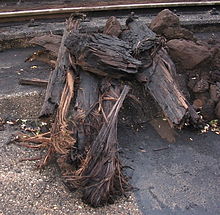Xylitol (charcoal)
Xylitol ( ancient Greek ξύλον xýlon , German 'wood' ) is millions of years old, not completely charred wood or plant material extracted from open-cast mining , in which in part very clear wood structures are still recognizable. Other common names for xylitol are lignite and shale coal . In the English-speaking world, exclusively in North America, any form of lignite is called lignite , where xylite is called xyloid lignite .
Over a period of millions of years, coalification leads from fresh plant material to humic acids and peat , then via lignite, brown and hard coal to anthracite , and in some cases even to graphite .
Xylitol was formed more than 10 million years ago. Its color is dark brown. The structures of wood are almost always recognizable. It occurs in a strongly fragmented form, as compact, flat xylitol stalks or as chunky or bar-like.
Xylitol as an energy source
Xylitol is found in lignite deposits and is separated from the coal in the processing process. Its utility value in thermal power plants is low because of its low calorific values and the extraction is usually not profitable. However, Ljubljana covers 90% of its district heating needs from lignite extracted from Velenje . When burning lignite, a lot of carbon dioxide (CO 2 ) is produced. The CO 2 release in the process is inherent in the principle and cannot be prevented, but only reduced to a certain extent through a better efficiency of the power plants and thus lower coal consumption, or the CO 2 can be subsequently separated out by CCS ( end of pipe ) . The sulfur dioxide , which is mainly produced when lignite is burned, is partly responsible for the acid rain .
Shale coal was often used as an additive with other types of coal or burned with a wood fire. In some cases, firing systems were specially converted for the burning behavior of this coal.
One new area of application is oiling. Using the technology of catalytic pressureless oiling (KDV), around 250 liters of diesel oil, around 300 to 350 kilograms of carbon paste and up to 350 liters of process water ( distilled water ) are produced from one ton of lignite .
Xylitol in horticulture
When processed, xylitol is suitable as an additive for the production of potting soil and professional substrates for commercial horticulture. Its chemical properties come close to the nutrient content of peat and its pH value is also in the acidic range. Its water holding capacity is lower than that of peat. The use of wetting agents in substrate production is therefore appropriate. The proportion of organic matter is over 85% based on the dry matter.
Advantageous properties of xylitol are good structural stability and low N- immobilization . There are hardly any easily accessible carbon sources and the xylitol is subject to a lower rate of degradation compared to other organic substances (C / N ratio> 200).
Heavy metals are only found in traces in xylitol and well below the limit values of the organic waste ordinance . Other pollutants relevant in crop production have not yet been detected either.
The analysis values vary slightly depending on the grain size and origin. A large number of studies have been carried out on the use of xylitol in horticulture since 2004.
swell
- Weidlich, Ariane (Ed.): Modern times - industrialization in rural Upper Bavaria ; Chapter: “We will never be able to enjoy the company” - From the ups and downs of mining activities on the edge of the Alps near Großweil; Author: Ernst Höntze; Pp. 38-52; Michael Imhof Verlag 2006; from the series of the Glentleiten Open Air Museum No. 30; ISBN 3-86568-124-7
Individual evidence
- ^ Slovenia - The Voice of Coal in Europe. Retrieved September 10, 2017 .
- ↑ http://www.horticon.net/daten/Xylit_DEGA.pdf
